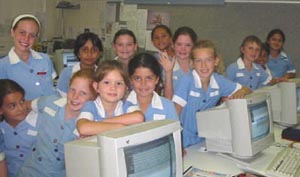|
What are the benefits of this global community?
Kidlink offers a variety of projects and programs in many languages that encourage inquiry and critical thinking for students from pre-school through secondary school. It also provides opportunities for youth to meet in free-form discussions on topics of their choice. In addition to the many projects that Kidlink offers students, it also provides a web environment called KidSpace where students and teachers can post their online work. www.kidlink.org/kidspace Kidlink's virtual community includes activities for learners of all ages and offers an environment for communication among all who are members.
Limitations or "challenges" of this technology Students must register in Kidlink to be active participants. In order to register, students answer the four Kidlink questions. These are excellent questions and can fit well within many curriculum areas.
In 1997 a creative teacher in Alaska designed a lesson that sent students to the Kidlink response database online to research what other students entered for their responses. Diving into Cyberspace--The Early Days She writes in her article: Instead of just textbook facts and figures about countries and cultures of the world, my students learned they had a great deal in common with children everywhere--even though they ate different foods, celebrated different holidays, and sometimes had different goals in life. This intense interest in the responses naturally led to an expanded study. What an excellent opportunity that only the online virtual community can offer! The four Kidlink questions also bring "challenges" and hurdles for some students and teachers. Web forms cannot be saved so students must complete the form in one class period. For some, this is a challenge. Younger students need more time to complete the form than older students. Kidlink also insists on complete names for students. Some school districts will not allow students to give their last name online. Kidlink's database of registered students does not make personal information available on the Web. Only first name, age, country and the responses by the student are visible. Here is a sample from the public database: Kidlink's policy about using full names is explained on their web site: A quote from the webpage above: Kidlink invites you to make friends in areas, and use our resources to build personal networks of friends. Anonymity destroys friendship. Also, we need this information to see that you have the right to a nickname. The benefits of belonging to this virtual community far outweigh the challenges. In my twelve years online I have not seen a more well developed virtual community. Kidlink has a broad network of volunteers to support students and teachers... for free! Back to Communication Tools - Main Page |
|
|
| home | greetings | new | kids | teachers | visitors | resources |
Patti Weeg |
